Negligence on construction sites can cost lives, money, and time. You might think accidents are rare, but they happen every day. Workers face risks like falling objects or unstable structures, and these dangers often stem from simple neglect. Ignoring safety rules or failing to provide proper training puts everyone in harm’s way. You have the power to change this by staying alert and informed. Regular inspections, effective communication, and proper equipment make a big difference. When you actively address negligence on construction sites, you protect not just the workers, but their families too. You safeguard their future. It’s crucial to remember that safety is not just a checklist. It’s an ongoing commitment. Your actions today can prevent the tragedies of tomorrow. By recognizing the role you play, you contribute to a safer environment and a more responsible industry. Take a stand against negligence now, because every life matters.
Understanding the Causes of Negligence
Negligence often arises from overconfidence, lack of training, or rushing to meet deadlines. Each of these factors can lead to oversight or errors. Simple mistakes, like misplacing tools or neglecting protective gear, contribute to larger issues. Without proper oversight, these small lapses can lead to disastrous outcomes.
You should ensure that each worker understands their safety rules clearly. Training sessions that review past incidents can help highlight potential hazards. This not only increases awareness but also fosters a culture of accountability.
Consequences of Ignoring Safety Protocols
Ignoring safety protocols doesn’t just endanger workers. It affects entire projects. Delays arise from accidents and legal complications. You could face fines and penalties, impacting your financial standing. Families of injured workers endure emotional and financial hardships.
Statistics on Construction Site Accidents
An analysis by the Occupational Safety and Health Administration (OSHA) reveals that “one in five worker deaths in 2019 was in construction.” These incidents often result from falls, being struck by objects, or getting caught in machinery. By addressing these issues, you can significantly reduce accidents.
| Cause of Accident | Percent of Total Accidents |
|---|---|
| Falls | 39% |
| Struck by Object | 8% |
| Electrocutions | 7% |
| Caught-in/Between | 5% |
Steps to Improve Safety on Construction Sites
Here are three essential steps to enhance safety:
- Conduct Regular Training: Keep your team updated on safety practices. Refresher courses and hands-on training sessions prevent knowledge gaps.
- Use Proper Equipment: Ensure all equipment meets safety standards. Regular maintenance checks help avoid malfunctions.
- Implement Strong Communication: Encourage open dialogue about safety concerns. Create a culture where workers feel comfortable reporting potential hazards.
These steps create a foundation for a safer work environment. When safety becomes integrated into everyday tasks, everyone benefits.
Resources for Construction Safety
Access valuable resources to enhance safety on your site. The Occupational Safety and Health Administration (OSHA) offers guidelines and support. Explore their training programs to keep your team informed. Additionally, the National Institute for Occupational Safety and Health (NIOSH) provides research and recommendations aimed at improving worker safety.
The Role of Leadership in Preventing Negligence
As someone in a leadership role, you set the tone for safety. Your commitment influences others. Lead by example and prioritize safety in every decision. Recognizing and rewarding safe practices can encourage others to follow suit. This approach not only reduces accidents but also boosts morale and productivity.
Conclusion
Negligence on construction sites poses significant risks. By understanding its causes and consequences, you can take proactive steps. Emphasize regular training, proper equipment, and open communication. Use resources like OSHA and NIOSH for guidance. In the end, a safe construction site benefits everyone involved. Prioritize safety now, because every life matters.


